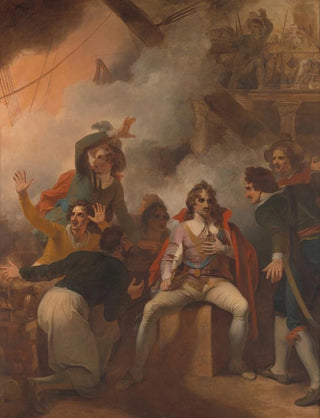Art print | The Earl of Sandwich refusing to abandon his ship during the Battle of Solebay - Robert Smirke


View from behind

Frame (optional)
In the vibrant universe of art, some works transcend the simple frame of painting to become visual narratives of evocative power. The art print The Count of Sandwich refusing to abandon his ship during the Battle of Solebay - Robert Smirke immerses us in the heart of a significant historical episode, where courage and determination intertwine in a vivid tableau. This piece, depicting a key moment of the Battle of Solebay in 1672, portrays the Count of Sandwich, an emblematic figure of the English navy, defying the elements while remaining true to his duty. The staging, both dramatic and heroic, captures attention and invites reflection on sacrifice and honor.
Style and uniqueness of the work
Smirke's work is distinguished by its neoclassical style, which combines rigor and expressiveness. The figures are sculptural, almost theatrical, enhancing the intensity of the scene. The contrast between light and shadow, carefully orchestrated, emphasizes the emotions of the characters and the palpable tension of the battle. The colors, though dark, are highlighted by bright touches, creating an atmosphere that is both dramatic and captivating. This representation is not limited to a simple illustration of a military event; it also evokes universal themes such as duty, sacrifice, and bravery in the face of adversity. The composition, skillfully balanced, guides the viewer's gaze across the tableau, allowing for full immersion in this historical scene.
The artist and his influence
Robert Smirke, British painter of the early 19th century, is often associated with the renaissance of historical art in England. Trained in the context of neoclassicism, he managed to blend tradition and innovation, influencing many artists of his time. His approach to historical painting helped redefine the codes of representation, emphasizing storytelling and emotion. Smirke was also a fervent advocate of art print, believing strongly in its power to educate and inspire.

Matte finish

View from behind

Frame (optional)
In the vibrant universe of art, some works transcend the simple frame of painting to become visual narratives of evocative power. The art print The Count of Sandwich refusing to abandon his ship during the Battle of Solebay - Robert Smirke immerses us in the heart of a significant historical episode, where courage and determination intertwine in a vivid tableau. This piece, depicting a key moment of the Battle of Solebay in 1672, portrays the Count of Sandwich, an emblematic figure of the English navy, defying the elements while remaining true to his duty. The staging, both dramatic and heroic, captures attention and invites reflection on sacrifice and honor.
Style and uniqueness of the work
Smirke's work is distinguished by its neoclassical style, which combines rigor and expressiveness. The figures are sculptural, almost theatrical, enhancing the intensity of the scene. The contrast between light and shadow, carefully orchestrated, emphasizes the emotions of the characters and the palpable tension of the battle. The colors, though dark, are highlighted by bright touches, creating an atmosphere that is both dramatic and captivating. This representation is not limited to a simple illustration of a military event; it also evokes universal themes such as duty, sacrifice, and bravery in the face of adversity. The composition, skillfully balanced, guides the viewer's gaze across the tableau, allowing for full immersion in this historical scene.
The artist and his influence
Robert Smirke, British painter of the early 19th century, is often associated with the renaissance of historical art in England. Trained in the context of neoclassicism, he managed to blend tradition and innovation, influencing many artists of his time. His approach to historical painting helped redefine the codes of representation, emphasizing storytelling and emotion. Smirke was also a fervent advocate of art print, believing strongly in its power to educate and inspire.






